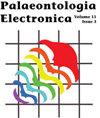A Lower Valanginian coral fauna from the South Iberian Palaeomargin (Internal Prebetic, SE Spain)
IF 1.5
4区 地球科学
Q1 Earth and Planetary Sciences
引用次数: 4
Abstract
From the Lower Valanginian of the Sierra de Cazorla (Internal Prebetic, SE Spain), a coral fauna is taxonomically described. The fauna encompasses 51 species in 29 genera. One genus and three species are described as new. The most speciesrich are the superfamilies Cyclolitoidea and Stylinoidea. The faunal composition is ambivalent and encompasses typical Jurassic taxa, such as members of the families Amphiastraeidae, Rhipidogyridae, Solenocoenidae and Stylinidae, but also typical Cretaceous elements such as the genera Confusaforma, Floriastrea and Holocoenia (which also have their first occurrence in the Valanginian studied fauna). Four Jurassic genera show a range extension into the Early Valanginian: Alloiteaucoenia, Bilaterocoenia, Hykeliphyllum and Miscellosmilia. Other genera still survived into the Late Valanginian (Placogyra, Rhipidogyra and Solenocoenia) but became extinct. A palaeobiogeographic analysis shows relationships of the studied fauna to the Tithonian and the Kimmeridgian of the northern Tethys on one hand, and the Hauterivian of the Paris Basin and the Puebla Basin (Mexico) on the other. Nineteen species of the studied fauna remained in open nomenclature; the majority of them probably represent new species. Hannes Löser. Universidad Nacional Autónoma de México, Instituto de Geología, Estación Regional del Noroeste, L.D. Colosio s/n, 83000 Hermosillo, Sonora, Mexico. loeser@paleotax.de Luis M. Nieto. Departamento de Geología y Centro de Estudios Avanzados en Ciencias de la Tierra, Energía y Medio Ambiente (CEACTEMA), Universidad de Jaén, 23071 Jaén, Spain. lmnieto@ujaen.es José Manuel Castro. Departamento de Geología y Centro de Estudios Avanzados en Ciencias de la Tierra, Energía y Medio Ambiente (CEACTEMA), Universidad de Jaén, 23071 Jaén, Spain. jmcastro@ujaen.es Matías Reolid. Departamento de Geología y Centro de Estudios Avanzados en Ciencias de la Tierra, Energía y Medio Ambiente (CEACTEMA), Universidad de Jaén, 23071 Jaén, Spain. mreolid@ujaen.es来自南伊比利亚古边缘的下瓦兰吉尼亚珊瑚动物群(西班牙东南部的内史前世)
从Sierra de Cazorla的下Valanginian(西班牙东南部的内史前世),分类描述了珊瑚动物群。动物群包括29属51种。新发现1属和3种。种类最丰富的是花柱总科和花柱总科。区系组成是矛盾的,包括典型的侏罗纪分类群,如Amphiastraeidae科、rhiidogyridae科、Solenocoenidae科和Stylinidae科,也包括典型的白垩纪分类群,如Confusaforma属、Floriastrea属和Holocoenia属(也首次出现在Valanginian研究的动物群中)。4个侏罗纪属(Alloiteaucoenia、bilatererocoenia、Hykeliphyllum和Miscellosmilia)的分布范围延伸至早期瓦兰吉尼亚。其他属仍然存活到晚期瓦兰吉尼亚(Placogyra, hipidogyra和Solenocoenia),但已经灭绝。一项古生物地理学分析表明,研究的动物群一方面与特提斯北部的提通纪和基默里吉纪有关,另一方面与巴黎盆地和普埃布拉盆地(墨西哥)的Hauterivian有关。所研究的动物群中有19种仍属公开命名法;它们中的大多数可能代表了新物种。汉斯·失败者。墨西哥国立大学Autónoma莫西莫研究所Geología, Estación东北大区,科罗拉多分校,墨西哥索诺拉埃莫西约83000号。loeser@paleotax.de路易斯·m·涅托。Geología与地岛科学研究中心系,Energía与环境媒体研究中心(CEACTEMA),雅桑坦大学,西班牙雅桑坦23071。lmnieto@ujaen.es何塞·曼纽尔·卡斯特罗。Geología与地岛科学研究中心系,Energía与环境媒体研究中心(CEACTEMA),雅桑坦大学,西班牙雅桑坦23071。jmcastro@ujaen.es Matías Reolid。Geología与地岛科学研究中心系,Energía与环境媒体研究中心(CEACTEMA),雅桑坦大学,西班牙雅桑坦23071。mreolid@ujaen.es
本文章由计算机程序翻译,如有差异,请以英文原文为准。
求助全文
约1分钟内获得全文
求助全文
来源期刊

Palaeontologia Electronica
地学-古生物学
CiteScore
3.60
自引率
0.00%
发文量
20
审稿时长
>12 weeks
期刊介绍:
Founded in 1997, Palaeontologia Electronica (PE) is the longest running open-access, peer-reviewed electronic journal and covers all aspects of palaeontology. PE uses an external double-blind peer review system for all manuscripts. Copyright of scientific papers is held by one of the three sponsoring professional societies at the author''s choice. Reviews, commentaries, and other material is placed in the public domain. PE papers comply with regulations for taxonomic nomenclature established in the International Code of Zoological Nomenclature and the International Code of Nomenclature for Algae, Fungi, and Plants.
 求助内容:
求助内容: 应助结果提醒方式:
应助结果提醒方式:


